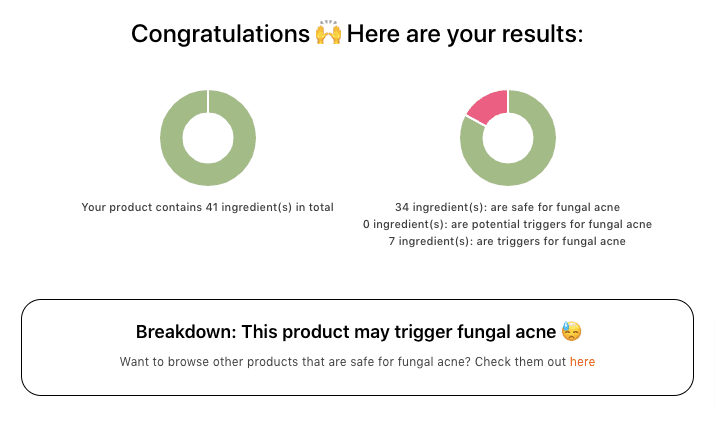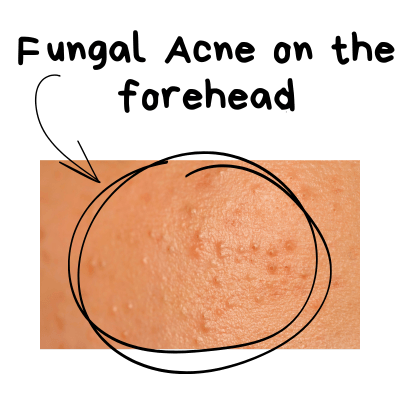Fungal Acne Ingredient Checker
Can't find a product in our database? Copy-paste the ingredient list of the product in the box below:
💡 How it works 💡
➀ Copy the ingredient list of your product in the grey box above.
You can get the ingredient list from reliable retailers (f.ex. Sephora) or the product manufacturer.
➁ Click on the blue 'Analyze-my-product'-button.
This step is easy :)
➂ Your analysis is ready in a few seconds.
Check if your product is safe for fungal acne at a glance. Take the guesswork out of skincare!
Glow Coach
Questions our Fungal Acne Checker can answer
✅
Is the product safe for fungal acne?
✅
Is the product sls-free, paraben-free, mineral-oil, silicone-free, oil-free,... ?
✅
Does the product help with: combination skin, dry skin, oily skin, anti-aging,... ?
✅
Are the ingredients in the product safe (according to the organization CIR)?
✅
Is the product comedogenic (pore clogging)?
Example of the result: Check if a product is safe for fungal acne at a glance:

Glow Coach
What is Fungal Acne?
Fungal acne, scientifically known as Pityrosporum Folliculitis or Malassezia Folliculitis, is an acne-like skin condition. The forehead is a very common area for fungal acne.

Fungal acne looks similar to regular acne. That's why fungal acne is often mistaken for regular acne. And that's not ideal since the treatments differ a LOT!
Fungal acne, also known as Malassezia Folliculitis or Pityrosporum Folliculitis, is a skin condition caused by an overgrowth of the yeast Malassezia on the skin's hair follicles. This overgrowth, typically triggered by factors like excessive sweating, humidity, or certain skincare products, leads to inflammation and acne-like bumps, often accompanied by itching.
The most significant difference between fungal acne and regular acne is that fungal acne is caused by yeast (Malassezia), and regular acne is caused by bacteria (P. acnes).
The so-called yeast Malassezia is a fungus naturally present on the skin. An overgrowth, typically triggered by factors such as excessive sweating, humidity, or certain skincare products, leads to inflammation and acne-like bumps, often accompanied by itching.
While there isn't a vast amount of dedicated research specifically focused on "fungal acne", there are many studies on Malassezia folliculitis, the underlying condition.
Glow Coach
Do I have Fungal Acne?
The main characteristics of fungal acne are:
✅
Stubborn small bumps, especially in oilier areas (forehead)
✅
Bumps are red or white (whiteheads) in color
✅
Skin appears uneven
✅
Can be itchy
✅
Acne treatment doesn't help
If the key points are true for your skin, chances are high that fungal acne is an issue.
Fungal acne is characterized by small, uniform, red or white (whiteheads) bumps. The bumps can be itchy. They often appear in oily areas, such as the forehead.
Many anti-acne products fail to fight these stubborn bumps. The reason: A large number of ingredients can be categorized as triggers for fungal acne.
That's why products, that are well-proven to fight regular acne, can't work properly on fungal acne.
Many well-known anti-acne products fail to fight fungal acne. The reason: A large number of ingredients are potential triggers for fungal acne. If a (anti-acne) product contains potential triggers for fungal acne, it can't work properly and is likely to worsen your skin condition.
Glow Coach
What ingredients are fungal acne-safe?
Over 60,000 ingredients are used in cosmetics. That's a lot!
Before listing all the ingredients that are fungal acne-safe, let's take a look at the ingredients that are likely to trigger fungal acne.
✅
Fatty acids (number of carbon atoms C12 - C24) and fatty acid esters
✅
Vegetable oils, waxes, butter, and lecithin
✅
Polysorbates
✅
Amino acids (potential triggers)
✅
Ceramides and cholesterol (potential triggers)
✅
Fermented ingredients
Generally, it is better to avoid (or patch test) products, that contain these ingredient families. Keep in mind that even small quantities of these ingredients are likely to trigger fungal acne.
So what should you do? Scanning all the products for these ingredients without any help is impossible!
Right. That's why we've created the Glow Coach Fungal Acne Ingredient Checker :)
If you are prone to fungal acne: Make sure to check, if your skincare is fungal acne-safe. Our Fungal Acne Ingredient Checker can help you!
Glow Coach
How to treat fungal acne?
Once you have had fungal acne, you may be prone to it in the future. Keep this in mind when buying new skincare products.
Check all your skincare products with our Fungal Acne Ingredient Checker and choose products that are fungal acne-safe.
Additionally, follow our 2-step-treatment-recommendation.
➀ Step: 4-week treatment with Ketoconazole
The best-known anti-fungal acne treatment so far contains the ingredient Ketoconazole. An appropriate product is applied twice a week to the affected areas and washed off after 3 - 5 minutes. After 4 weeks, the blemishes should be significantly minimized.
➁ Step: Regular treatments
An appropriate exfoliant should be used at least once a week to keep fungal acne at bay. The exfoliant should preferably contain BHA (Salicylic Acid) or AHAs (Glycolic Acid/ Lactic Acid).
Other helpful ingredients that can be integrated into a daily skincare routine, are sulfur or urea.
Once you have had fungal acne, you may be prone to it in the future. So make sure to choose fungal acne-safe products: Our Fungal Acne Ingredient Checker can help!
Glow Coach
FAQ: Fungal Acne Checker
✅
Where does the information about the ingredients come from?
Our goal is to provide you with a fungal acne ingredient checker that is backed by scientific studies. The scientific studies are published by scientific journals. For our research, we use the database of the National Center of Biotechnology Information (NCBI). We try to primarily evaluate in-vivo studies (tests on human skin) from independent organizations (not from skincare manufacturers or ingredient suppliers).
✅
There are some ingredients with no information. Why?
This can happen. It means that - at the moment - there is no information on the ingredient available. Since our database is constantly growing and new researches on ingredients are being published, new information may be added soon! So make sure to check your products on a regular basis :)
✅
I found a mistake! What can I do?
Please get in touch with us so we can take care of it. Thank you!
✅
How can I get the most out of the fungal acne checker?
Every time you're looking for new skincare: Check if the product is fungal acne-safe. This can save you a lot of frustration. Another tip: We think that the starting point for effective and satisfying skincare is knowing your skin type and skin concerns. By knowing your skin type and skin concerns, you understand what your skin needs. You can then easily find products that give your skin exactly what it needs with the help of glowcoach.co. The result: effective skincare for your unique skin and the skin you want.
Further Reading & Proof:
DermaNet NZ (2019): Malassezia folliculitis. Published online:https://www.dermnetnz.org/topics/malassezia-folliculitis/ (17. April 2025)
JClinical and Experimental Dermatology, Volume20, Issue5, September 1995, Pages 406-409. Pityrosporum (Malassezia) folliculitis in Saudi Arabia—diagnosis and therapeutic trials.
British Journal of Dermatology, April 2000, 142(4), Pages 758-65. In vitro susceptibility of the seven Malassezia species to ketoconazole, voriconazole, itraconazole and terbinafine.
Cureus, November 2024, 16(11), Malassezia Folliculitis: Pathogenesis and Diagnostic Challenges, Published online:https://pmc.ncbi.nlm.nih.gov/articles/PMC11633069/. (17. April 2025)
Cureus, February 2021, 13(2), Malassezia (Pityrosporum) Folliculitis Masquerading As Recalcitrant Acne, Published online:https://pmc.ncbi.nlm.nih.gov/articles/PMC7996476/. (17. April 2025)



